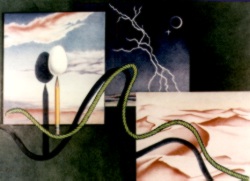A Brief Description by PPO

Egg ©1998 . Nikki Fay
All rights reserved

numbers, music, anything in sequence.
Allow me to help you understand the autistic mind.

 |
 |
To the autistic mind, there is one way to recall it
By tracing it.
 |
(touch) (sound) (taste) (vision)
 |
(sound) (taste) (vision) (smell)
 |
The Jack of Clubs could be a sound.
(taste) (vision) (smell) (touch)
 |
The Queen of Clubs could be a taste.
(vision) (smell) (touch) (sound)
 |
(smell) (touch) (sound) (taste)

Each on a journey to find recollection;
the coveted Ace.
This Ace, could be a popsicle, a jacket, a drink of water or a book.
| Most autistic children are nonverbal. Once they have traced the memory/need, the next challenge is finding the right word to verbalize it or ask for what they want. They don't know how to express what they need or want; therefore, the screams of frustration come. They have to be taught other ways to communicate besides speaking such as using sign language and picture symbols. |
|
Example: An autistic boy was told to "kick the ball" by a teacher. The teacher knew he could. The little boy did not kick the ball. The teacher said, "kick the ball with your FOOT." The little boy did not kick the ball. The teacher said, "kick the ball with your SHOE." The little boy kicked the ball. Finding the right word is the key to communicating with an autistic child. |
| When I was first working with Sean I discovered the very same thing-- the importance of finding the connection, the right word to get results. I was feeding Sean a bite of toast. I said, "eat it" and he didn't. I then said "BITE IT" and he did! |
|
Also: Autistic children have a problem with transition. Something as simple as moving a plate two inches can cause a tantrum. This is NO exaggeration. Many times what causes a tantrum is not even noticed as we take things like moving objects for granted. Cleaning the house can be very difficult. The shifting of objects, putting them back in their normal place is often not acceptable to the autistic child. Many times it is just a single object that they don't want disturbed. We had a "sit & spin" toy in the center of our living room floor for several weeks because Sean had to have it there!! The TEACCH program addresses this issue. This program takes "the mystery" out of the transition. It is designed to help autistic children know ahead of time, where they are going or what is expected of them next. For ex: At school, Sean is given a cap when it is time to go to P.E. This let's him know where he is going so he can better handle the transition. |

|
I Can Do Many Things...
To Sean
I can do many things, though smarts I may not have. I can drive a car, wash a dish or two. I can paint and draw, smile at you. I can make your bed, sing off key. I can offer love for free. I will do many things, though mistakes will be made. I will love you till the sun burns away. I will cover your cuts with a Pooh bandaid. I will read to you on a rainy day. But, there are many things I cannot do. I cannot melt your demons into rain. I cannot guess everything you want. I cannot understand your misery and pain. I am as lonely as you, dear son. Though, we are together, apart. I promise to try till this war is won. I must remove this dagger from my heart. ©1998 Peggy Putnam Owen |

A Clinical Explanation